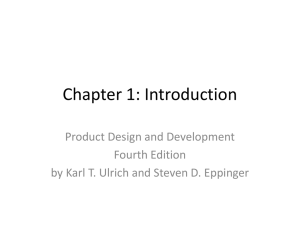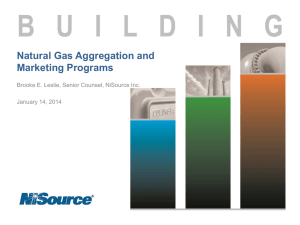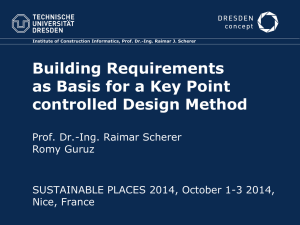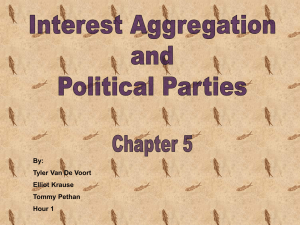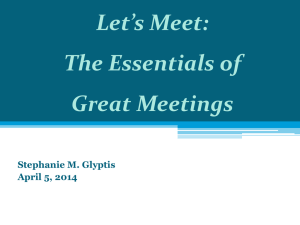SEMO Extraordinary Mods Meeting slides_V2
advertisement
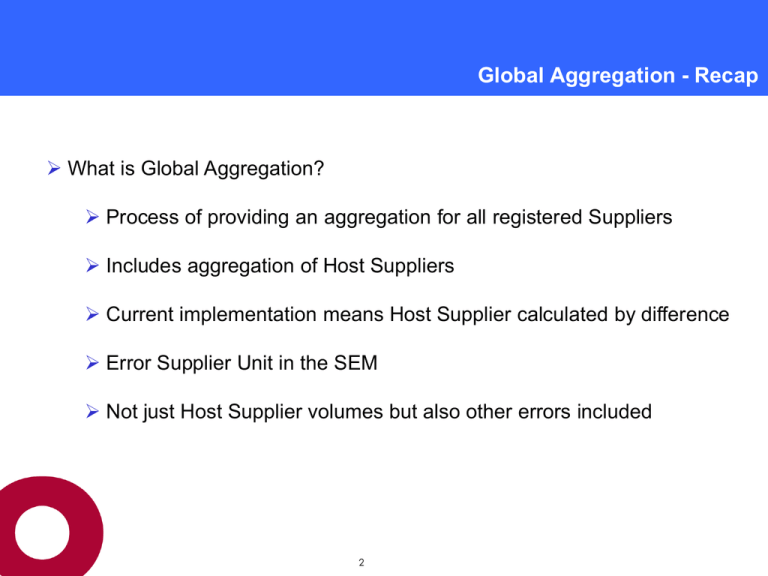
Global Aggregation - Recap What is Global Aggregation? Process of providing an aggregation for all registered Suppliers Includes aggregation of Host Suppliers Current implementation means Host Supplier calculated by difference Error Supplier Unit in the SEM Not just Host Supplier volumes but also other errors included 2 Global Aggregation - Recap HH Meters Tran Loss factors Readings Meter data processing Data Aggregation AUFs and EUFs Meter data processing Difference Profiled Demand for NHH customers Units delivered to BSP in Each Jurisdiction HHM metered units Residual volume assigned to NIEES /ESBN using Error Supplier Units Readings NHH Meters (STS only) Generator Output Metered or profiled volumes are uplifted in DA to reflect distribution line losses Global Aggregation - Recap HH Meters Readings Meter data processing Profiled Demand for NHH customers Include DN LLFs Data Aggregation HHM metered units AUFs and EUFs Include DN LLFs Meter data processing Readings Tran Loss factors Variance Units delivered to BSP in Each Jurisdiction Generator Output Variance is ‘smeared’ across Suppliers, method to be determined through SEMO Metered or profiled volumes are uplifted in DA to reflect distribution line losses (reports show both vols) Global Aggregation - Recap Causes of imbalance? Physical inaccuracy Back door supplies Interconnector losses Meter errors Meter errors Umetered embedded generation Theft Line losses Transformer losses Power Stations & interconnectors Transmission Network Distribution Networks Customers (end users) 5 Global Aggregation - Recap Causes of imbalance? Data Errors Station aggregation rules TLAFs Power Stations & interconnectors DLAFs Transmission Network Distribution Networks Umetered Supply Profiles Energisation Status Customers (end users) 6 Global Aggregation - Recap Causes of imbalance? Elexon experience of Global Aggregation; Incorrect profiles of non-interval meters considered chief contributor; Modification 34_09 developed with a view to smearing residual volume across all suppliers, taking account of each suppliers share of non-interval metered consumers; 7 Global Aggregation - Recap Mod 34.09 raised by ESB CS Mod proposed separation of SU into Interval SU and Non-Interval SU Raised at Mods Meeting 24 (29.09.09) Mods Panel recommended setting up Working Group to explore further Terms of reference for Working Group circulated, Nov 2009 8 Global Aggregation - Recap Working Group 1, held on 19th November 2009. Presentations & Discussion – ESB CS suggested assigning ESU to non-competing Party under the Code; MDPs presented on impact on systems; Actions – SEMO & RA to meet to further develop options; ESB CS & NIE to provide estimation of error; Mods Panel to decide if impact assessments should be sought; 9 Global Aggregation - Recap SEMO & RA met December 1st to develop options paper; Four options written up and circulated – Option A – recovered through SEMO balancing cost; Option B – smear across Suppliers based on annual factors; Option C – smear across Supplier based on monthly factors; Option D – as set out in modification proposal; 10 Global Aggregation - Recap Working Group 2, held on 23rd February 2010. Presentations & Discussion – Suppliers presented on magnitude of actual error; SEMO & MDPs presented results of impact assessments; MRSO proposed option E, further enhancement on option C; Actions – SEMO & MDPs to meet to further review options D and E; SEMO to impact assess options A+ and E; 11 Global Aggregation - Recap Meeting between MRSO, NIE T&D and SEMO took place on March 5th; Further review of Options D and E; Option E confirmed as Aggregation for Supplier Units as normal; Inclusion of a % value for each Trading Period; % value will indicate at a MW level the proportion of the aggregation that is made up of non-interval metering; 12 Global Aggregation - Recap Working Group 3, held on 27th April 2010. Presentations & Discussion – SEMO presented on MDP meetings and further impact assessments; EirGrid presented on TUoS impacts; Actions – SEMO to issue consultation on options A+ and E; TSO to review implementation of Option A for TUoS; 13 Global Aggregation - Recap Consultation document issued on June 17th; Participants asked to express preference between Option A+ and Option E; Responses welcomed on discarded options B, C and D; Nine responses received to Consultation Five responses favoured Option E (2 Participants, 3 service providers) Three responses favoured Option A+ One response recommended either option 14 Global Aggregation - Recap Working Group 4, held on 26th August 2010. Presentations & Discussion – Recap and review of consultation responses; Full impact assessment on SEMO systems is approx 1200 hours or €210 K Noted flexibility in Option E to allow for implementation in one jurisdiction ahead of the other; Stressed importance of decision; Consensus reached on recommendation of Option E; 15 Global Aggregation - Recap Current Design Metered Generation Loss Adjusted MGLF - NDLF Metered Demand by Supplier Unit 16 Error Supplier Unit Global Aggregation - Recap Option E Design Metered Generation Loss Adjusted MGLF - NDLF Error Supplier Unit Metered Demand by Supplier Unit Metered Generation Loss Adjusted MGLF - NDLF Metered Demand by Supplier Unit 17 Residual Meter Volume & Smearing Global Aggregation - Recap NDvh 1 NIEPvh NDvh NIEPvh NDAvh REVLFeh RMVIPy 1 RMVIPy ANINDeh AINDeh After calculation of residual error volume; Allocated across all Suppliers in the SEM; Residual Meter Volume Interval Proportion – sets how much of the error volume is allocated based on a Suppliers interval metered customers; Non-Interval Energy Proportion – advises what portion of the aggregated Metered Demand is based on non-interval metered customers; Global Aggregation - Recap Version 2 of modification before Committee today; Meeting with subgroup of Participants to review detail; Further discussions with RAs on Version 2; A number of changes are proposed for legal drafting; Intent of the modification is not impacted by proposed changes; Global Aggregation - Recap Version 2 used the following as paragraph 4.91; NDLFv' h MGLFuh MDLFvh NIJIeh u ine v in e Legal suggestion is to retain current 4.91, changing NDLFv’h to NDLFeh; NDLFeh (MGuh) (MDvh) NIJIeh u in e v in e ( MGuh) NIJIeh u in e ( MGuh) ( MGLFuh) ( MDLFvh) ( MDvh) MGuh u v v u e uine Global Aggregation - Recap NDLFeh MGLFuh MDLFvh NIJIeh u ine v ine Paragraph 7.12 updated also; Creation of NDLFeh allows the value to be allocated to either the Error Supplier Unit or the Residual Error Volume Paragraph 4.91A Paragraph 4.91 B NDLFv ' h NDLFeh If no Error Supplier Unit is registered in Jurisdiction e in accordance with paragraph 2.59, REVLFeh NDLFeh Global Aggregation - Recap NDvh 1 NIEPvh NDvh NIEPvh NDAvh REVLFeh RMVIPy 1 RMVIPy AINDeh ANINDeh Paragraph 4.92C separated out to two sections to provide Net Demand Adjustment percentage for Suppliers. NDvh 1 NIEPvh NDvh NIEPvh NDAFvh RMVIPy 1 RMVIPy ANINDeh AINDeh NDAvh REVLFeh NDAFvh

